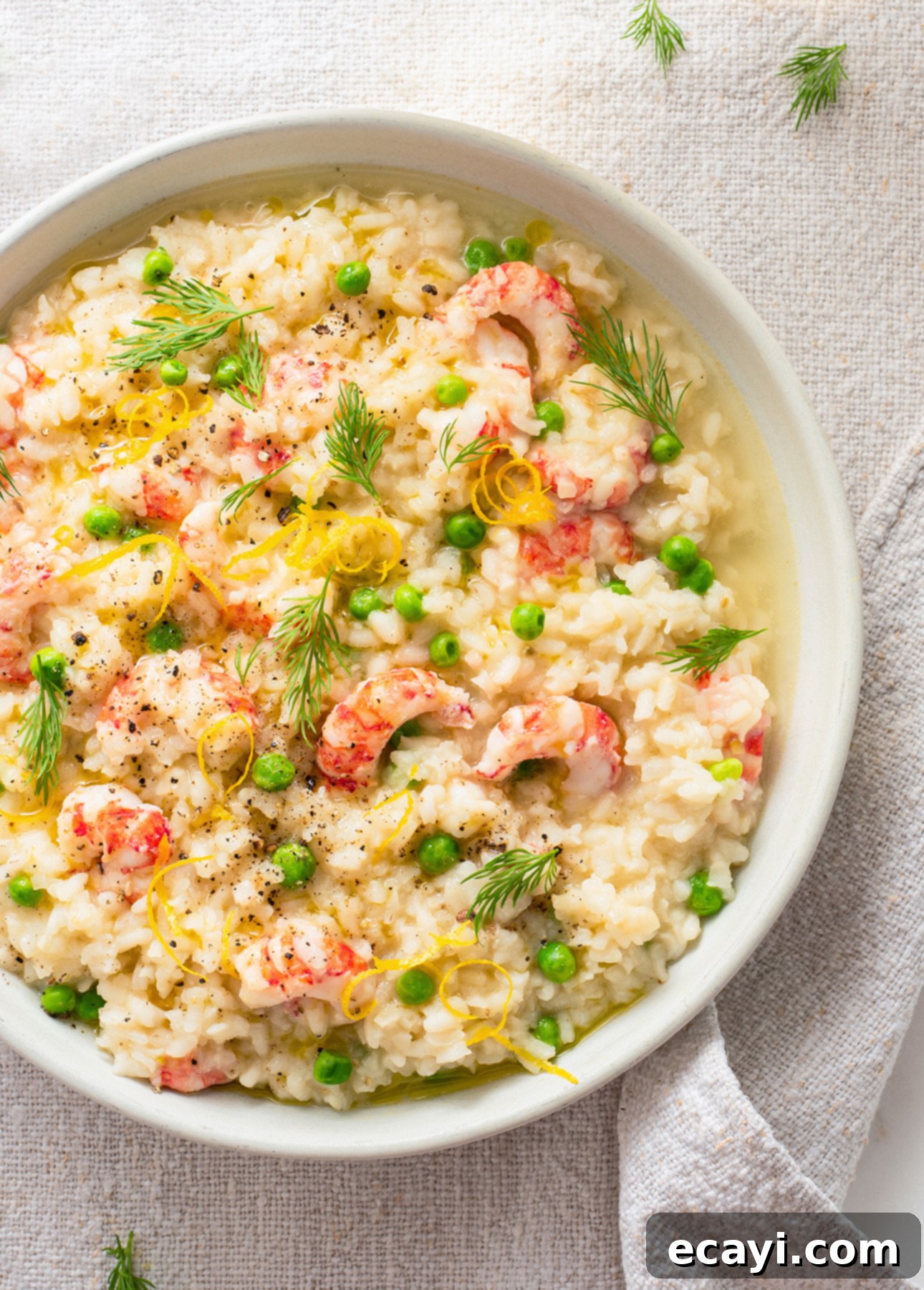Easy Weeknight Shrimp and Pea Risotto: A Zesty Lemon-Garlic Delight
Discover the joy of creating an incredibly flavorful and vibrant dish that’s as elegant as it is effortless. This delightful shrimp risotto bursts with bright, aromatic notes from fresh fennel, pungent garlic, and zesty lemon, perfectly complemented by the sweetness of peas and succulent shrimp. It’s an ideal meal that truly feels special, yet is remarkably quick and simple enough to whip up on even the busiest weeknights.
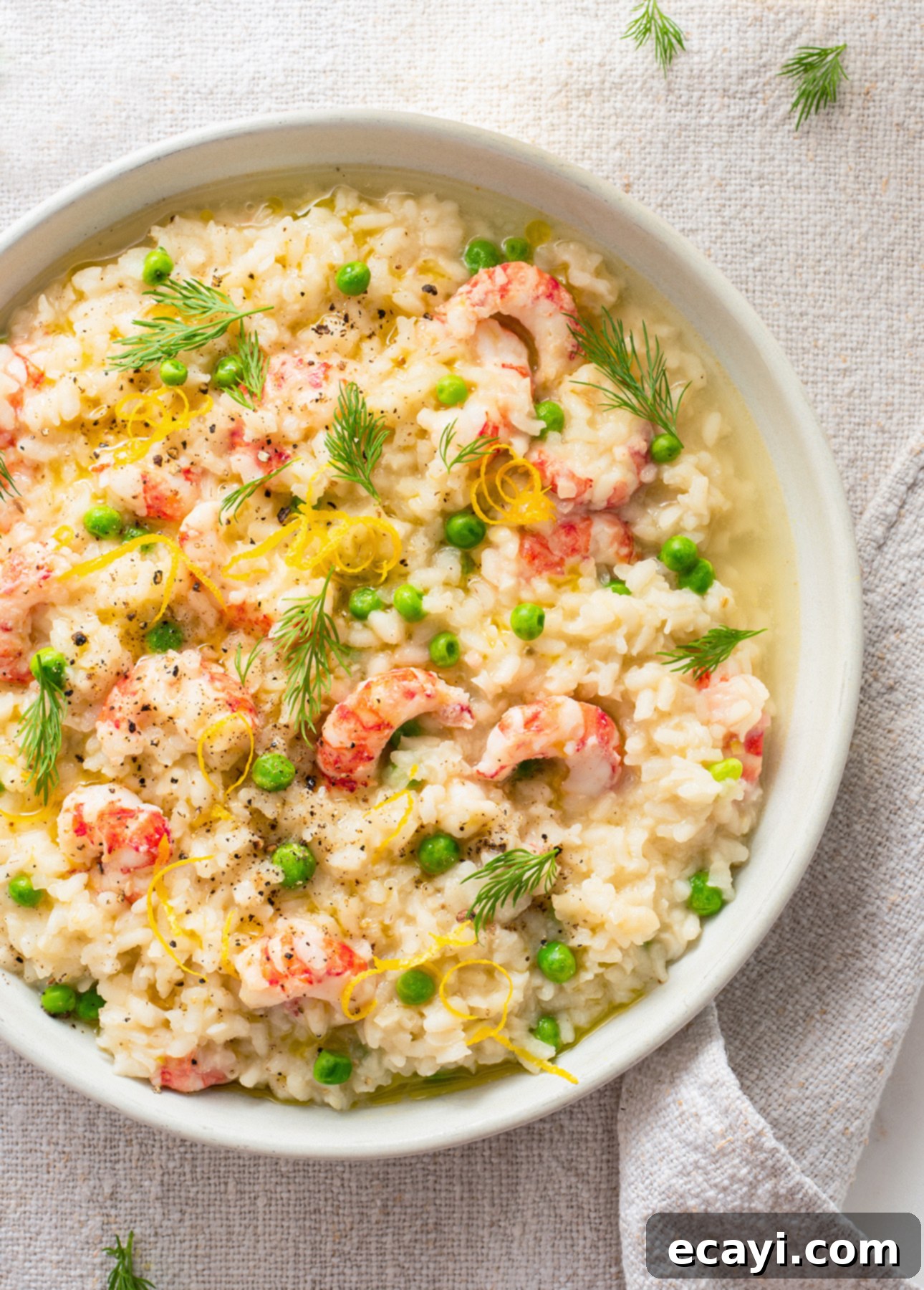
This post contains affiliate links. Full disclosure is at the bottom of the article.
Isn’t it one of life’s little culinary pleasures when a specific dish calls to you, and you realize you have every single ingredient on hand to make it right then and there? For me, this delightful serendipity often happens with risotto, primarily because of my deep affection for this creamy, comforting Italian staple. It’s a dish I find myself preparing almost weekly, which means I always keep a trio of essential ingredients stocked in my pantry:
- High-quality risotto rice (such as Arborio, Carnaroli, or Vialone Nano)
- Premium stock (whether chicken, vegetable, or a delicate seafood stock)
- Fine blocks of Parmigiano-Reggiano and Pecorino Romano cheeses.
Armed with these three foundational components, I can transform a seemingly ordinary array of pantry, fridge, and freezer items into a truly spectacular and soul-satisfying risotto. It’s like having a blank canvas, ready to be painted with whatever fresh flavors and textures I desire.
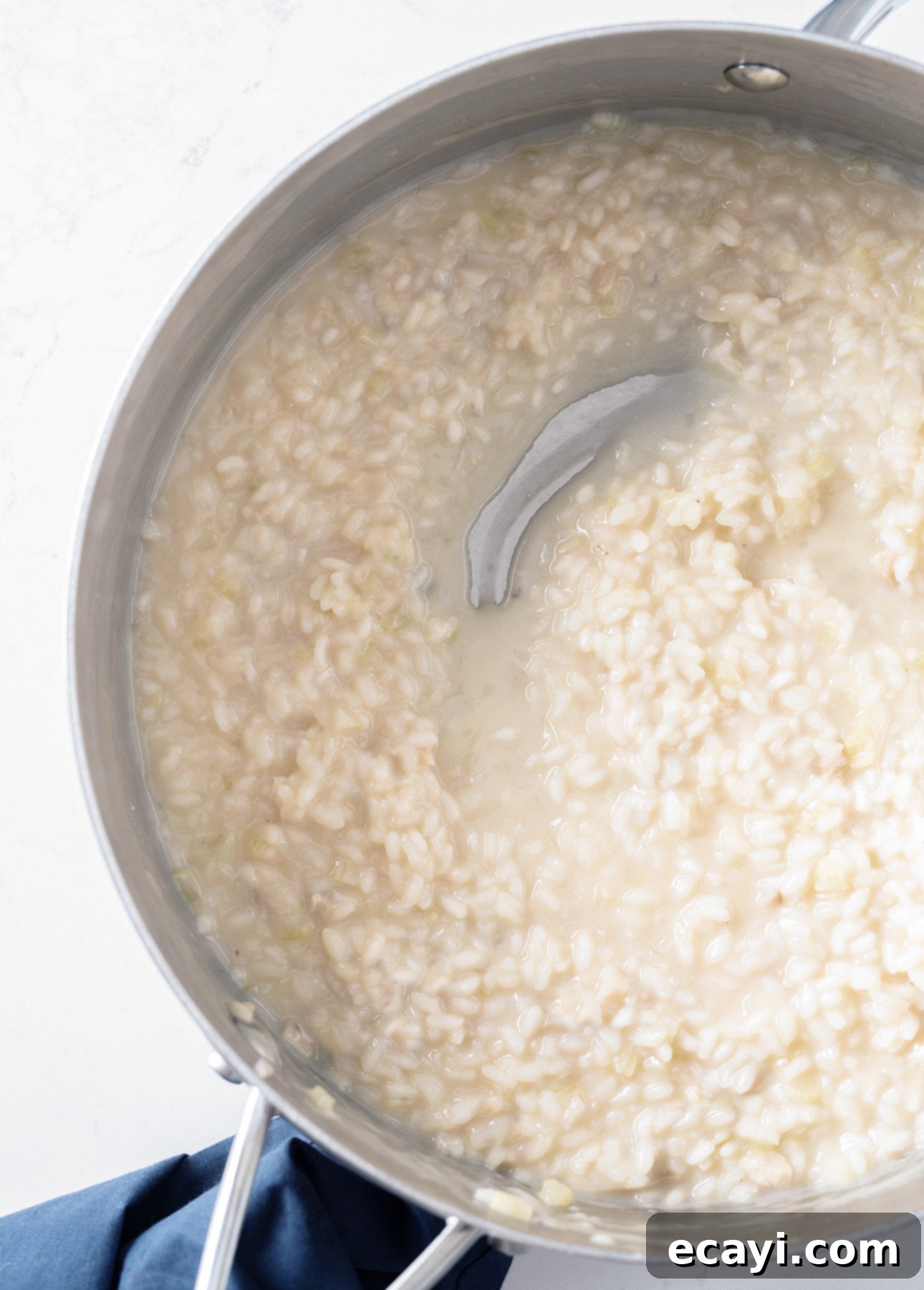
Consider the endless possibilities: If you happen to have a robust head of cauliflower, you can quickly broil the florets until tender, then fold them into a luxurious, cheesy risotto, perhaps with a touch of chili flakes for warmth. The result is a dish so comforting and utterly delicious, it rivals even the most beloved mac & cheeses.
Perhaps you have an abundance of fresh, sweet corn? Let it be the undisputed star in an all-corn risotto, allowing its natural sweetness to shine. Or, for an elevated and truly special spring dinner, consider combining it with delicate crab meat to create a refined seafood risotto that impresses without effort.
If a large bunch of vibrant kale is awaiting its purpose, transform it into a vivid green pesto. Swirl this nutrient-rich pesto into a creamy, cheesy risotto and top with toasted walnuts for a delightful textural contrast and nutty flavor.
And if you’re fortunate enough to stumble upon a basket of fresh, sweet, green peas, their natural charm is simply begging to be showcased. You can feature them prominently in a refreshingly vegetarian green pea risotto, or, as we explore in this recipe, combine their bright sweetness with juicy shrimp to create a colorful, elegant dish that is surprisingly quick and simple enough for any busy weeknight.
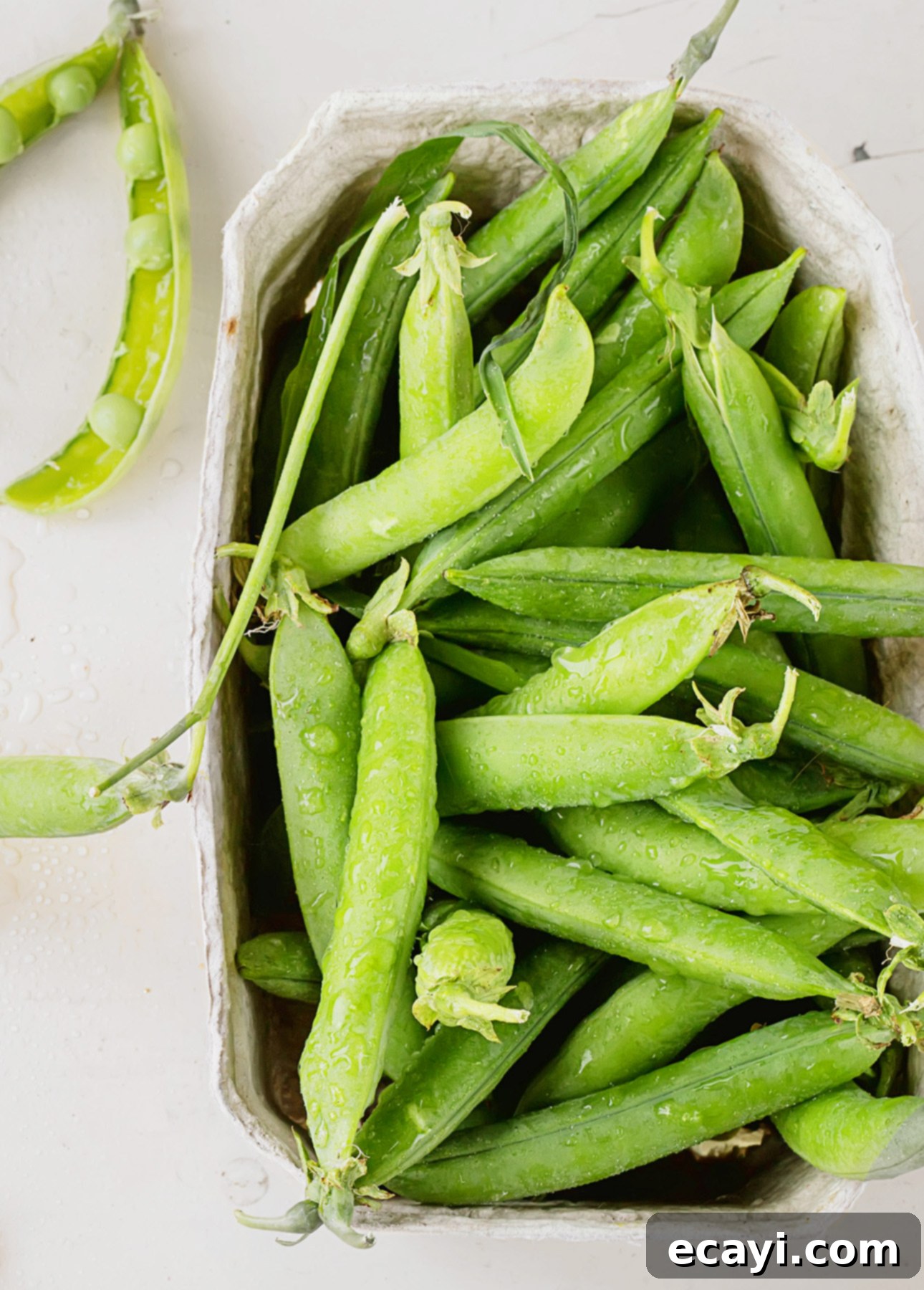
This particular shrimp risotto is a masterpiece of balanced flavors. Its aromatic foundation is built upon the subtle warmth of crushed fennel seeds, the pungent depth of freshly minced garlic, and the bright, uplifting zest and juice of lemon. The addition of vibrant green peas not only contributes a delightful pop of color but also a burst of natural sweetness. A final flourish of fresh dill leaves amplifies the dish’s freshness, making every spoonful incredibly invigorating. This risotto truly comes together in a snap, especially if you opt for pre-cooked shrimp and shelled peas from your freezer, yet it delivers surprisingly complex layers of flavor and an utterly irresistible combination of textures—from the tender, succulent shrimp to the slightly crisp peas, all enveloped in a rich, cheesy, and lusciously gooey rice. It’s a harmonious blend that engages all your senses.
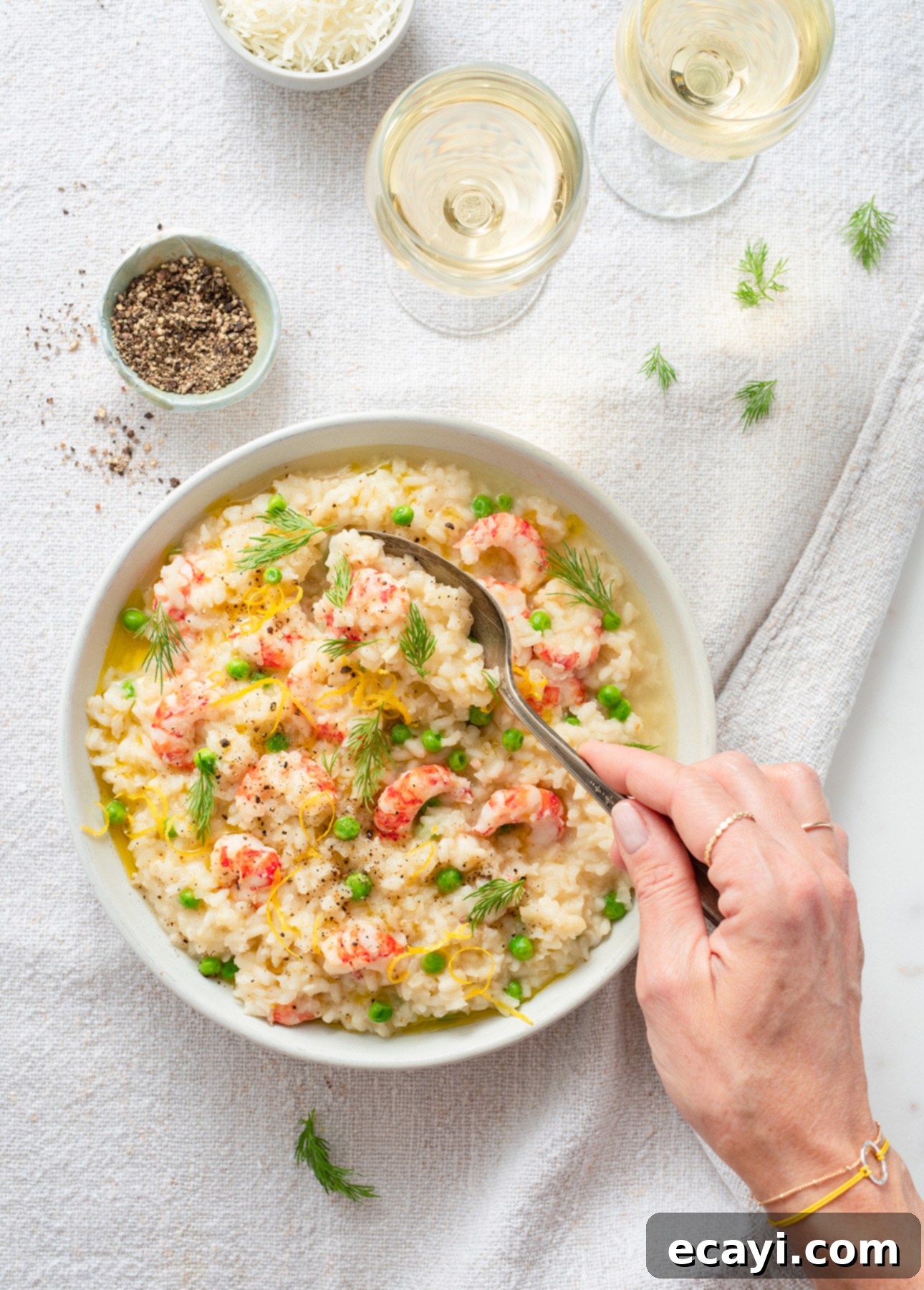
While this shrimp risotto is undoubtedly sophisticated enough to impress at a dinner party, I wholeheartedly encourage you to make it a regular feature on your weeknight menu. Imagine coming home after a long, demanding day at the office—or wherever your work takes you—and treating yourself to this incredibly delicious and comforting reward. It’s more than just a meal; it’s a moment of culinary indulgence that you absolutely deserve, a delicious testament to the simple luxury of homemade food.
Expert Tips for Crafting Your Perfect Shrimp Risotto with Peas
The Golden Rule: Quality Ingredients Elevate Your Risotto to Culinary Heights
As is so often the case with many simple, yet profoundly delicious, Italian-inspired dishes, the secret to achieving truly extraordinary flavor lies in the quality of your ingredients. Using the very best components you can access or reasonably afford will make the most significant difference in the final taste of your dish. For this particular shrimp risotto, I highly recommend seeking out a high-quality fish or seafood stock. If possible, explore your local fishmonger’s offerings; they often have homemade stock available in their freezer section. Homemade stock provides a much milder, more nuanced flavor profile that enhances the other ingredients without overpowering them, which I find canned fish or seafood stock tends to do. If using canned stock, a useful tip is to dilute it with water, aiming for a ratio of 2 parts stock to 1 part water. This softens its intensity, ensuring your main risotto ingredients—the delicate shrimp and sweet peas—remain the stars of the show.
Furthermore, the choice of rice is paramount for achieving that signature creamy risotto texture. Opt for a premium risotto rice variety: Arborio, Carnaroli, or Vialone Nano are all excellent choices, known for their high starch content which releases beautifully to create a velvety sauce. Finally, don’t overlook the importance of Pecorino Romano cheese for this recipe. Its unique sharp, salty, and aromatic qualities are key to rounding out the delicious flavors of this shrimp and pea risotto. While Parmigiano-Reggiano is a classic, Pecorino Romano offers a distinct character that truly makes this dish sing.
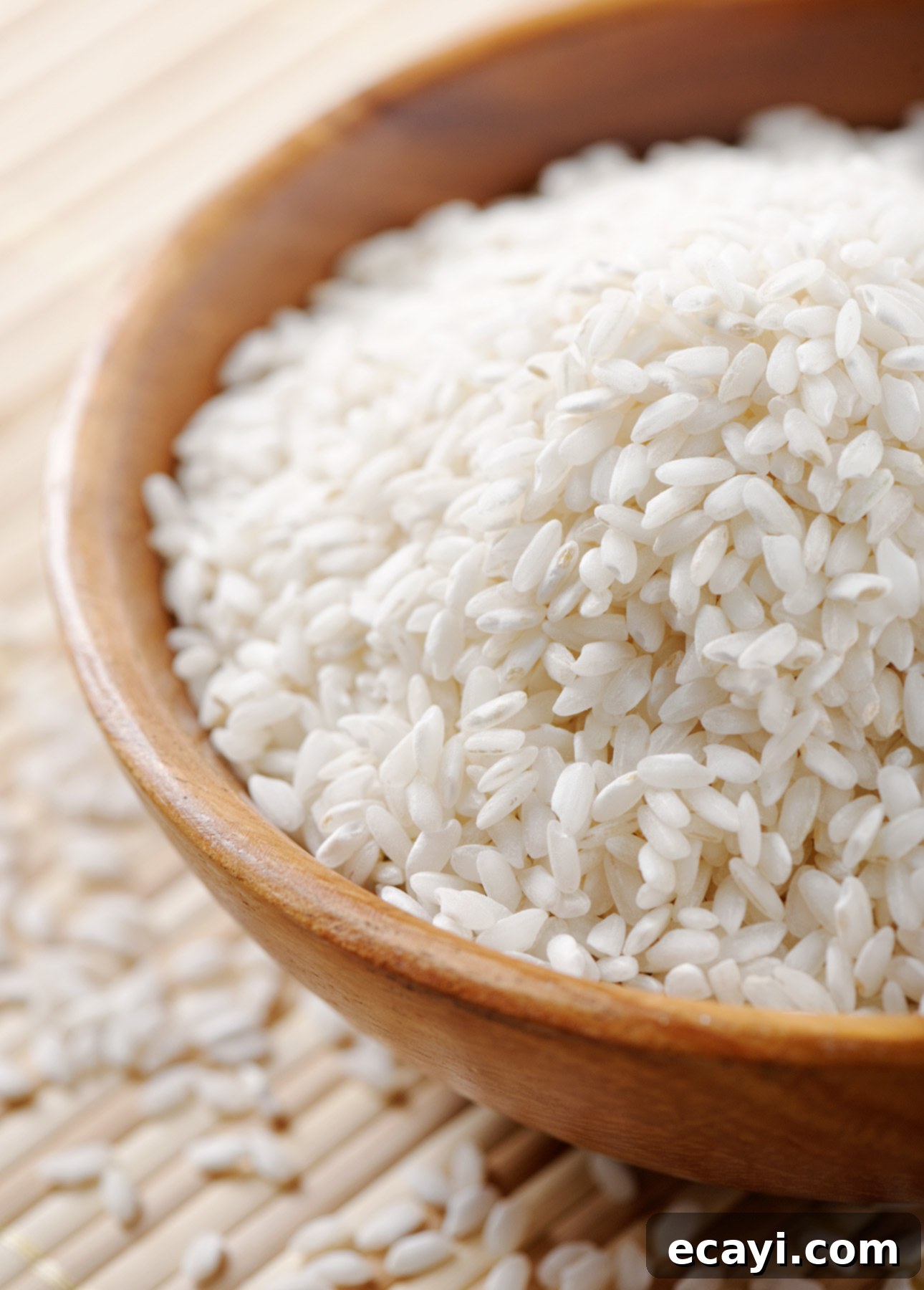
Navigating Cheese in Seafood Dishes: A Delicious Dilemma
The culinary world often debates the pairing of cheese with seafood. Traditional Italian wisdom, for instance, dictates that cheese should never grace seafood pasta dishes; you’ll rarely find it offered in Italy. However, culinary rules are often made to be thoughtfully bent, especially when the results are as delicious as in this shrimp risotto. I believe that a judicious amount of Pecorino Romano cheese adds a truly delightful creaminess and an invaluable depth of flavor to this dish, enhancing its overall richness without overpowering the delicate seafood. Ultimately, the decision is yours, but I find the slight departure from tradition to be well worth it here. Rest assured, this shrimp risotto would still be wonderfully delicious sans cheese if you prefer to adhere strictly to the traditional Italian approach.
Why Pecorino Romano Shines in This Shrimp Risotto
While Parmigiano-Reggiano cheese is a common and beloved ingredient in many risotto recipes, for this specific shrimp and pea risotto, I prefer the distinctive character of Pecorino Romano cheese. Pecorino Romano is a hard, aged Italian cheese crafted from sheep’s milk, distinguishing it from the cow’s milk base of Parmigiano. It boasts a notably sharp, wonderfully piquant, and slightly peppery flavor, along with a super aromatic profile. These qualities make it the perfect counterpoint to the mild, sweet flavors of shrimp and peas, providing a balancing zest and complexity. However, it’s crucial to remember that Pecorino Romano is considerably saltier than Parmigiano-Reggiano. Therefore, you’ll need a smaller quantity to impart ample flavor and creaminess without making the dish overly salty. A key tip: wait until you’ve fully incorporated the Pecorino Romano into your risotto before adding any additional salt to the recipe. Depending on the inherent saltiness of your chosen cheese, you might find that no extra seasoning is required at all.
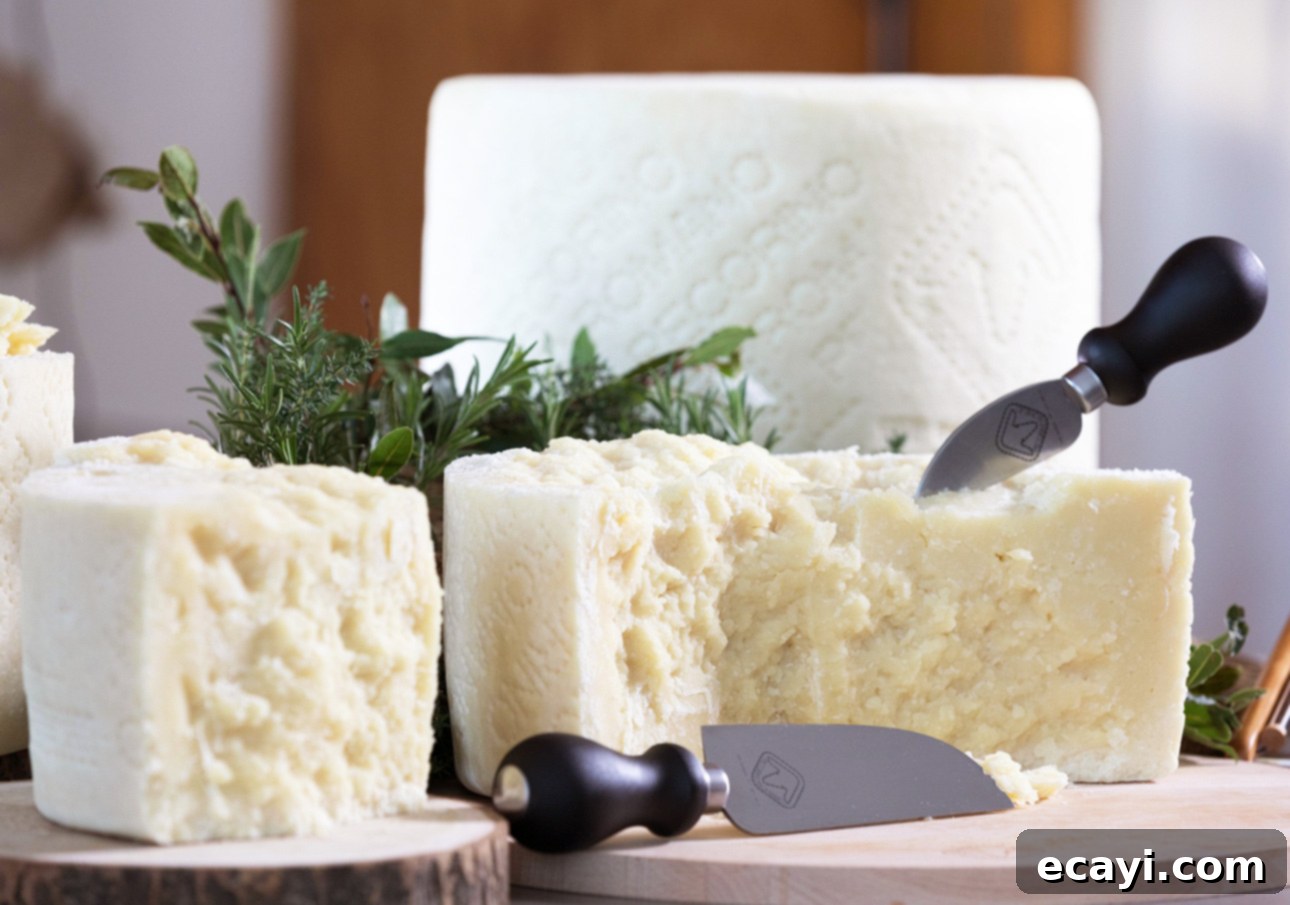
Photo: Consorzio per la tutela de Pecorino Romano
Choosing the Right Shrimp for Your Risotto
One of the beauties of this shrimp risotto recipe is its flexibility when it comes to the shrimp itself. For ultimate convenience and speed, especially on a busy weeknight, using precooked, frozen shrimp is a fantastic shortcut. I particularly favor tiny Northern shrimp (also known as Northern prawns) for their naturally sweet flavor and their ability to defrost in mere minutes. Pink shrimp are another excellent option, available in a wide range of sizes. Smaller pink shrimp (typically 61 to 70 count per pound) are also incredibly handy as they thaw very quickly. If you opt for larger shrimp, simply cut them into bite-sized pieces before stirring them into the risotto to ensure even distribution and ease of eating.
Of course, for those who prefer, raw shrimp can also be used. To prepare, simply peel and devein them, then quickly sauté them in a touch of butter for a couple of minutes until they just begin to turn pink. Be cautious not to overcook them at this stage, as the residual heat from the risotto will continue their cooking process, ensuring they remain tender and succulent rather than rubbery.
Scaling This Shrimp Risotto Recipe for Any Occasion
Many traditional risotto recipes often yield 4 to 6 servings, with ingredient quantities that can be cumbersome to halve or quarter. This has always been a minor annoyance for me, as I frequently prepare risotto for just two people. To simplify things, I’ve designed all my risotto recipes, including this shrimp and pea version, to serve a generous two-person yield. This intentional sizing makes the math incredibly straightforward if you wish to scale up the ingredients to comfortably serve 4 or even 6 guests. While this recipe is designed for two, it produces a notably hearty serving—it could even stretch to three servings if presented as part of a more elaborate menu that includes appetizers and complementary side dishes. Feel free to adjust based on your appetite and company!
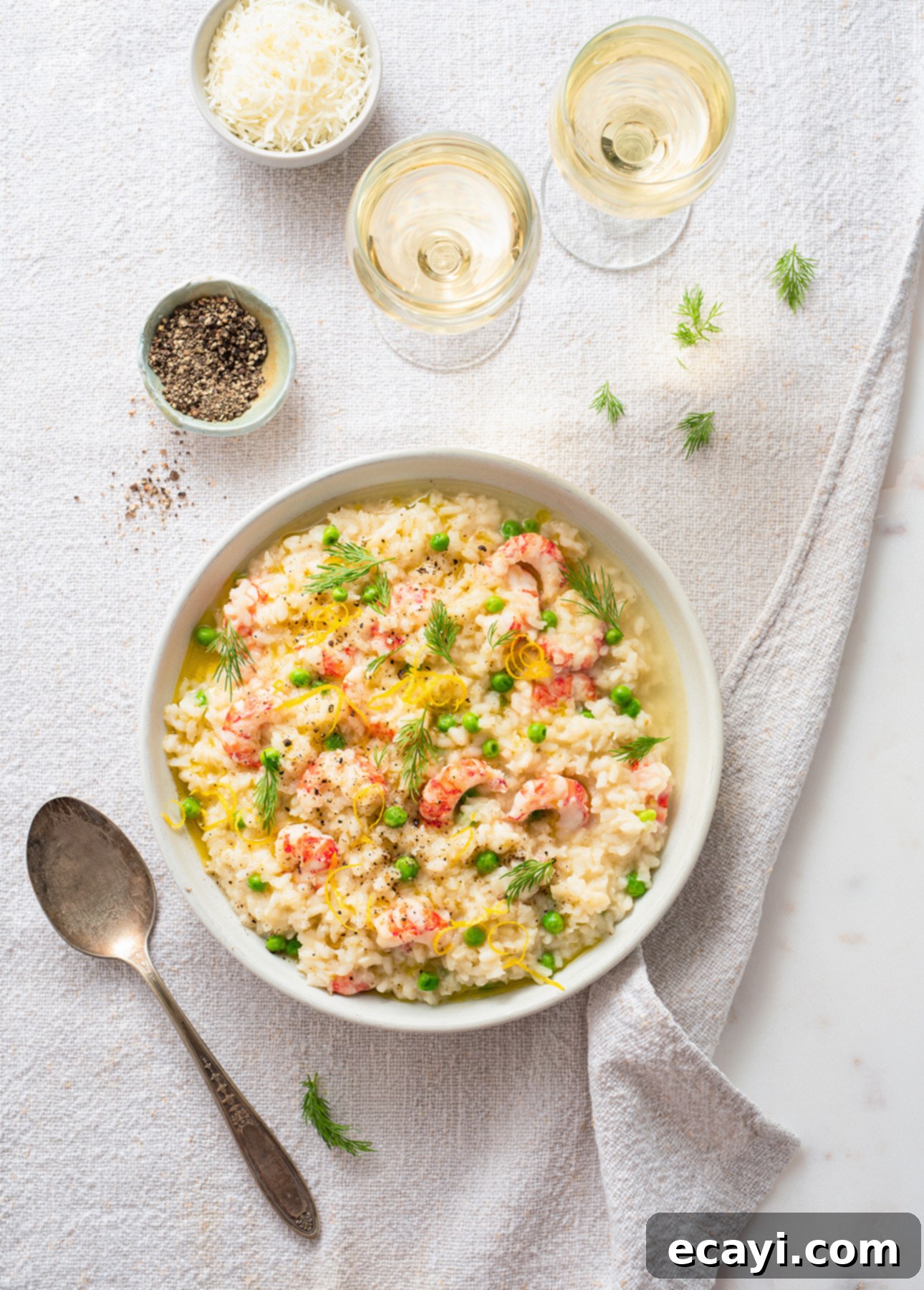
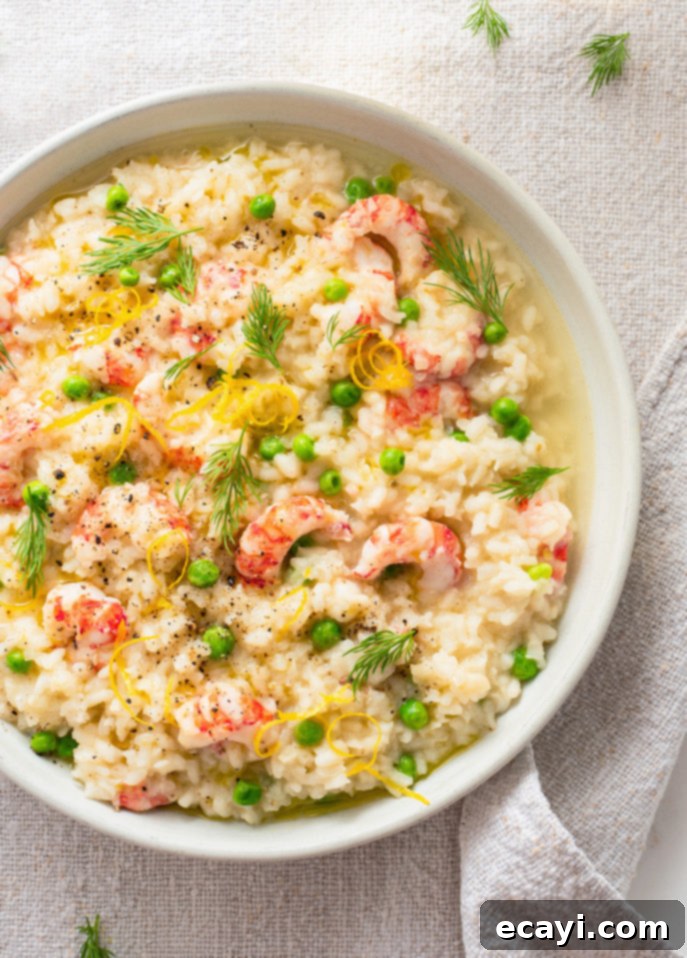
Pin Recipe
Shrimp Risotto with Peas
Ingredients
For the Shrimp Risotto
- 2 ¾ cups fish or seafood stock (see note)
- 1 tbsp butter
- 1 tbsp extra-virgin olive oil
- 1 shallot, minced, or substitute ¼ cup (60 ml) minced onion
- 1 clove garlic, minced
- ½ tsp crushed fennel seeds
- 5 oz risotto rice, such as Arborio, Carnaroli, or Vialone Nano
- ½ cup dry white wine, such as Pinot Grigio
- ½ cup frozen peas, thawed, or shelled fresh peas
- ½ lb cooked small shrimp
- 1 oz finely grated Pecorino Romano cheese
- Finely grated zest and juice from ½ lemon (about 1 tsp/5 ml zest and 2 tbsp/30 ml juice)
To Serve
- Fresh dill leaves
- Extra-virgin olive oil
- Freshly ground black pepper
Instructions
-
In a small saucepan, bring the stock to a simmer, then keep warm over low heat.
-
In a large saute pan or a cast-iron braiser set over medium-low heat, melt the butter in the olive oil. Add the shallot and cook, stirring, until soft, 3 to 4 minutes.
-
Add the garlic, crushed fennel seeds, and risotto rice and stir for 2 minutes, until the grains are translucent around the edges. Add the wine and stir vigorously while the wine is bubbling up, scraping down the bottom of the pan to loosen the caramelized bits. Simmer until the wine is fully absorbed.
-
Add 1 ladleful of the stock and simmer, stirring from time to time, until the stock is almost completely absorbed.
-
Continue adding broth, one ladleful at a time, allowing each ladle to be absorbed before adding more. When there’s about 1 cup (250 ml) stock left, stir in the peas and stir to incorporate. Add ½ cup (125 ml) broth, stir and keep cooking until the broth is almost fully absorbed.
-
Add the grated Pecorino-Romano cheese and stir until the cheese is fully melted and incorporated. Stir in the shrimp, lemon zest and juice, then season with black pepper. Taste the risotto, and season with salt if needed. Stir in the remaining broth.
The risotto should now be loose and super creamy. Cover and turn off the heat. The risotto can stand for about 5 minutes but should be served as soon as possible for the best texture.
-
SERVING: Serve the shrimp risotto in warm bowls, then garnish each serving with a drizzle of flavorful extra-virgin olive oil, a sprinkle of fresh dill leaves, and some freshly ground black pepper.
-
STORAGE: This shrimp risotto is best enjoyed within minutes of being made. If you do have leftovers, refrigerate in an airtight container for up to 2 days. To reheat, transfer to a nonstick skillet, add a couple tablespoonfuls of broth or water and warm up over medium-low until the risotto is loose and hot. Serve immediately.
-
NOTE: Fish or seafood stock is perfect for fish or seafood-based risotto because its rich aromas underlines the flavors of the fresh produce from the sea.
The best fish and seafood stocks are frozen when freshly made: ask your local fishmonger, chances are they have some in the freezer.
You will also find seafood stock in the soup aisle, sold in tetrapaks, just as chicken stock is.
Did you make this?
Tell me how you liked it! Leave a comment or take a picture and tag it with @foodnouveau on Instagram.
Disclosure Notice: This site is a participant in the Amazon Associates Program, an affiliate advertising program designed to provide a means for the site to earn fees by linking to Amazon and affiliated sites.
If you click on an affiliate link, I may earn advertising or referral fees if you make a purchase through such links, at no extra cost to you. This helps me create new content for the blog–so thank you! Learn more about advertising on this site by reading my Disclosure Policy.
